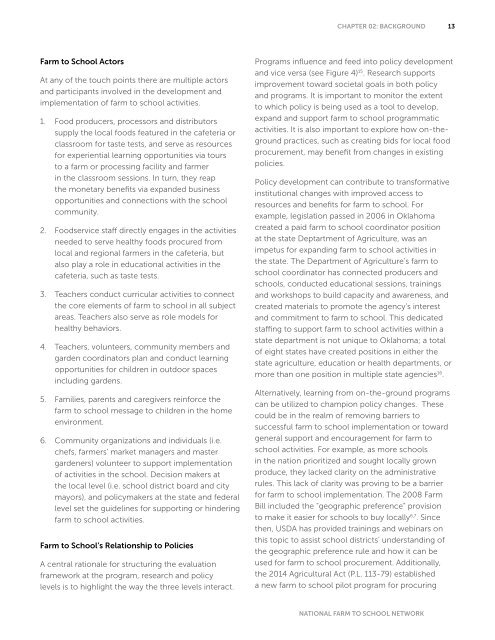Framework-08-25-14_web
Framework-08-25-14_web
Framework-08-25-14_web
You also want an ePaper? Increase the reach of your titles
YUMPU automatically turns print PDFs into web optimized ePapers that Google loves.
CHAPTER 02: BACKGROUND13Farm to School ActorsAt any of the touch points there are multiple actorsand participants involved in the development andimplementation of farm to school activities.1. Food producers, processors and distributorssupply the local foods featured in the cafeteria orclassroom for taste tests, and serve as resourcesfor experiential learning opportunities via toursto a farm or processing facility and farmerin the classroom sessions. In turn, they reapthe monetary benefits via expanded businessopportunities and connections with the schoolcommunity.2. Foodservice staff directly engages in the activitiesneeded to serve healthy foods procured fromlocal and regional farmers in the cafeteria, butalso play a role in educational activities in thecafeteria, such as taste tests.3. Teachers conduct curricular activities to connectthe core elements of farm to school in all subjectareas. Teachers also serve as role models forhealthy behaviors.4. Teachers, volunteers, community members andgarden coordinators plan and conduct learningopportunities for children in outdoor spacesincluding gardens.5. Families, parents and caregivers reinforce thefarm to school message to children in the homeenvironment.6. Community organizations and individuals (i.e.chefs, farmers’ market managers and mastergardeners) volunteer to support implementationof activities in the school. Decision makers atthe local level (i.e. school district board and citymayors), and policymakers at the state and federallevel set the guidelines for supporting or hinderingfarm to school activities.Farm to School’s Relationship to PoliciesA central rationale for structuring the evaluationframework at the program, research and policylevels is to highlight the way the three levels interact.Programs influence and feed into policy developmentand vice versa (see Figure 4) 15 . Research supportsimprovement toward societal goals in both policyand programs. It is important to monitor the extentto which policy is being used as a tool to develop,expand and support farm to school programmaticactivities. It is also important to explore how on-thegroundpractices, such as creating bids for local foodprocurement, may benefit from changes in existingpolicies.Policy development can contribute to transformativeinstitutional changes with improved access toresources and benefits for farm to school. Forexample, legislation passed in 2006 in Oklahomacreated a paid farm to school coordinator positionat the state Deptartment of Agriculture, was animpetus for expanding farm to school activities inthe state. The Department of Agriculture’s farm toschool coordinator has connected producers andschools, conducted educational sessions, trainingsand workshops to build capacity and awareness, andcreated materials to promote the agency’s interestand commitment to farm to school. This dedicatedstaffing to support farm to school activities within astate department is not unique to Oklahoma; a totalof eight states have created positions in either thestate agriculture, education or health departments, ormore than one position in multiple state agencies 16 .Alternatively, learning from on-the-ground programscan be utilized to champion policy changes. Thesecould be in the realm of removing barriers tosuccessful farm to school implementation or towardgeneral support and encouragement for farm toschool activities. For example, as more schoolsin the nation prioritized and sought locally grownproduce, they lacked clarity on the administrativerules. This lack of clarity was proving to be a barrierfor farm to school implementation. The 20<strong>08</strong> FarmBill included the “geographic preference” provisionto make it easier for schools to buy locally 6,7 . Sincethen, USDA has provided trainings and <strong>web</strong>inars onthis topic to assist school districts’ understanding ofthe geographic preference rule and how it can beused for farm to school procurement. Additionally,the 20<strong>14</strong> Agricultural Act (P.L. 113-79) establisheda new farm to school pilot program for procuringNATIONAL FARM TO SCHOOL NETWORK


